

Hilde Sørstrøm
Inger Blix Kvammen's artistic practice relies on a vast number of connections with individuals and communities from around the world. Memories from her travels to Northwest Russia, to Nenets Autonomous Okrug, Southern Caucasus, Turkey and Armenia lay the foundation for the objects she constructs back home in her studio in Hessing, a few kilometres outside of Kirkenes in Finnmark, Norway. In this interview by Hilde Sørstrøm we gain a closer insight into her process.
‘We see the world through the eyes of many people here [in Finnmark], not just Norwegian eyes, but also Sámi, Kven, Finnish and Russian eyes. All the migrants who have come here throughout history and in recent years, as refugees and economic migrants – they’re Arctic nomads in an expanded perspective’, says Kvammen, who has been interested in multicultural issues since her youth.
‘When I travel, it’s usually to study the life style and everyday reality of various cultures and groups in the areas I consider relevant for me. I have Sámi and Norwegian roots, but I wasn’t aware of my Sámi heritage until my late teens’, she adds.
Despite her Sámi heritage, Kvammen doesn’t feel she works in a duodji tradition.1
‘I don’t consciously think about what kind of tradition I work in, but I try to express my mixed cultural background and surroundings in my own way. I don’t know how others would categorise me, but the perspectives on nature and culture and on sustainability have a strong presence in the thinking that undergirds what I do’, says the artist, who was not raised in the duodji tradition or in that of contemporary or conceptual craft.
A ‘proper’ education
The art projects that Inger Blix Kvammen has been involved with in recent years are largely conceptual. Her works, which often consist of metal objects in combination with photos and other things, contain a whole range of stories from the North. They are ‘memory archives’, as the artist calls them.
But Kvammen’s path to her current conceptual art didn’t begin with an art education, as is common for most professional artists in Norway. There was no possibility to study art in Northern Norway when she was about to pursue higher education in 1973, and besides, the message from home was to get a ‘proper’ education. So she moved south, to study biology, chemistry and social science at the University of Bergen. In 1978 she and her husband returned to Finnmark and found jobs at a small school in Neiden – a village next to the Finnish border, with a strong Northern Sámi, Skolte Sámi, Norwegian, Finnish and Kven presence. That the school in Neiden lacked an art teacher would be highly consequential for Kvammen’s further career.
‘I was asked to teach art classes because I was so interested in art. My mother had sewn all our clothes. My grandmother had done the same. They were always working with various textile crafts, and as a child, I started doing the same things they did. I’ve actually almost never taught the school subjects for which I was trained’, she adds.
Kvammen taught in Neiden for four years. During this period, she also felt a great need to develop her interest in art further. This resulted in her taking classes in art, craft and art history. After expressing herself visually with textile works, she started working with contemporary metal jewellery. She studied with the goldsmith Liv Runningen in Oslo and took courses at the School of Jewellery at Birmingham City University. In England, she came into contact with new and important artistic circles. One of several key mentors was Barbara Cartlidge, who ran Electrum Gallery in London. Kvammen sent works to this well-known gallery for several years, and she participated in many of its exhibitions. On the whole, the trips to England gave her a vital boost; she was able to show her contemporary jewellery at exhibitions in San Francisco, New York City, Hamburg, London and several other places in Europe and the USA.
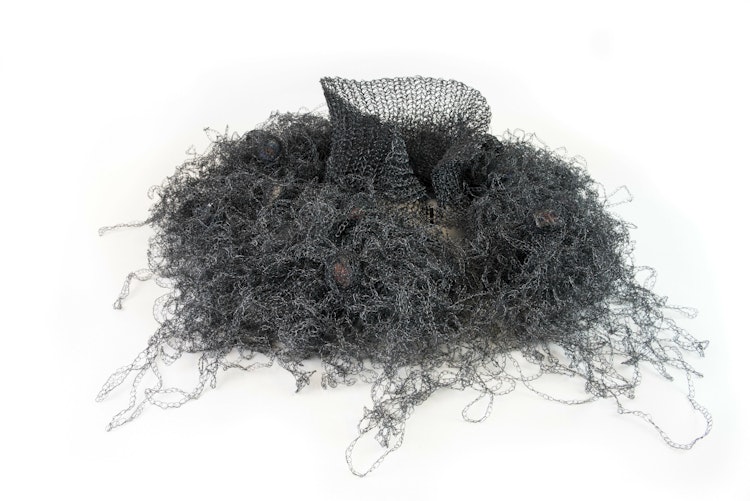
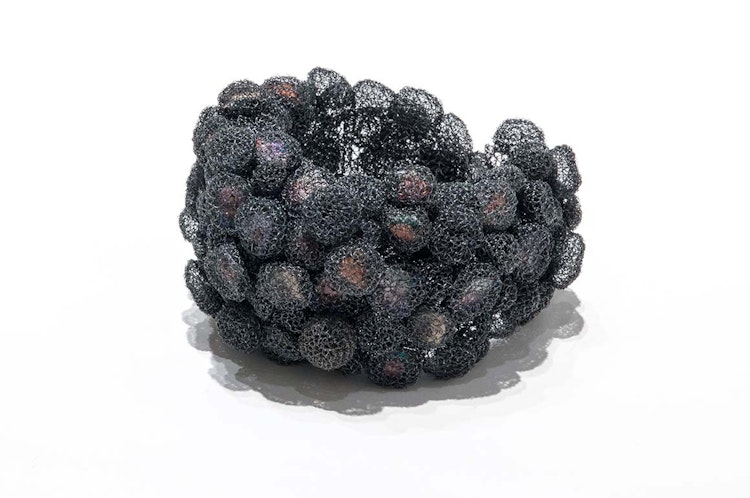
Contemporary jewellery in honour of women’s work
Characteristic for Kvammen’s contemporary jewellery is that she moves away from traditional silversmithing techniques and instead experiments with textile techniques – weaving, knitting, crochet and sewing – in combination with metal. She relates that, especially to begin with, the functional aspect was important to her:
‘I always tried to find textile solutions for clasps and linkages of various kinds. For example, by fusing elements together with sewing rather than soldiering. Someone was supposed to wear the object. It was supposed to have a clasp and be more than just an object. The aim was to make things that could be worn with pride, and to make it obvious that a person had crocheted, woven or sewn them by hand.’
It was while she was a teacher that she began emphasising these time-consuming and meticulous techniques that had been an important part of her own everyday life as well that of her mother and grandmother.
‘As a teacher, I discovered that the techniques I had learned at home – knitting, sewing, crochet and so on – were skills that pupils nowadays mostly learned at school. They weren’t things the young people needed in everyday life. They could of course buy everything in stores. So my aim, in large measure, was to elevate the textile techniques in order to give women’s work the honour it deserves.’
Stories about Indigenous culture and sustainability
As Kvammen’s experimentation progressed, she increasingly distanced herself from a user-orientation and adopted a more conceptual approach. This was partly because the jewellery format became too limiting for her; she wanted to express herself visually and to tell a broader story. Today, when her works are exhibited, they often appear as a combination of objects, text and documentation photos.
Trips to the Russian tundra have inspired the artist to emphasise a type of sustainability ideology that does not allow economic considerations to steer development. An important part of her artistic practice is to study how Sámi culture is situated today, and her contact with other indigenous groups gives her the opportunity to explore the Sámi culture in an expanded context.
‘Travelling to Nenets gives me the opportunity to see the Sámi culture and issues from a different perspective.’
The artist excitedly tells about her trip to Nenets in 2008, when she first met people who live on the Russian tundra.
‘I was in Arkhangelsk and just by chance was allowed to go to Cap Kanin by helicopter. There I met a group of 40–50 people who lived together and moved with the reindeer in the traditional way, without snow scooters. There were sleds, reindeer and chum – their tents.’
Seeing how the Nenets people practiced the traditional culture as much as possible made an enormous impact on Kvammen. These encounters also made it obvious that it wasn’t just the exploitation of natural resources in the area that limited their ability to practice their culture.
‘It’s a hard life, very demanding, and this also accounts for why people choose something different. Children and young people live and study at boarding schools in the nearest village. The impulses they receive there, through TV channels and a more modern lifestyle, cause many to choose something other than a hard life on the tundra. One young girl I met said she wanted to become a fashion designer when she grew up. The shortage of females is acute, and there were many bachelors without girlfriends.’
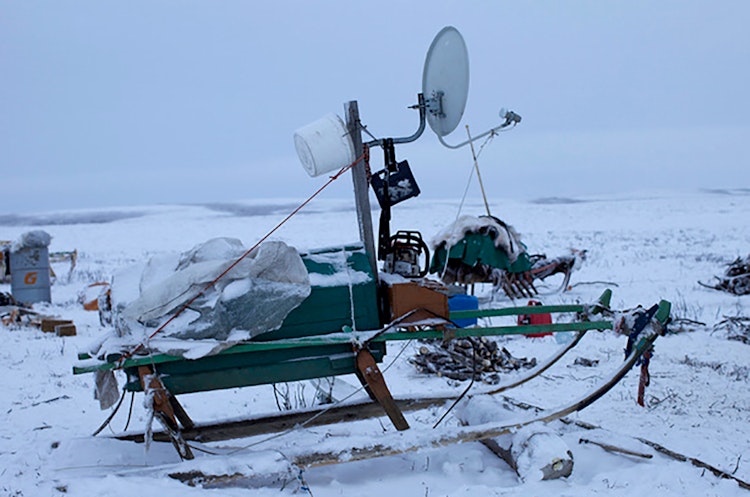
On another trip to Narjan Mar in Nenets, Kvammen got a surprising glimpse of a situation that she was able to capture in the photo Modern Times (2015), in the series Tundra Archives (2015).
‘On the tundra outside Narjan Mar, things were a bit different. Some people used snow scooters and some had TVs in their chum! Seeing parabolic antennas mounted on a traditional sled was quite an unusual sight. They sat inside the chum and watched the Russian talent contest Idol on TV, then went outside to tend the reindeer, then went back inside to watch Idol on their breaks. It was a strong contrast’, laughs Kvammen.
In addition to presenting photos on a gallery wall alongside her objects, she also experiments with putting photos into the objects themselves. In the work Tundra Girls (2012), for example, one can see how miniature portraits of women she has met on the tundra are fastened into the silver sculpture. In other cases, she incorporates found objects from her trips into her works.
‘In creating the objects, I often integrate elements that tell something about the lifestyle of the people I meet. For example, the bone and antler pieces that are used as fasteners for leather straps on reindeer bridles. Reindeer husbandry equipment is made largely from leather, antler and bone. Nowadays many of the fastening devices are made with plastic from the crates used to transport goods to the tundra. It’s about sustainability, using whatever is at hand’, says Kvammen, who thinks it’s possible to read something about how a culture has developed by noticing such things as the buttons and fastening devices the people use.
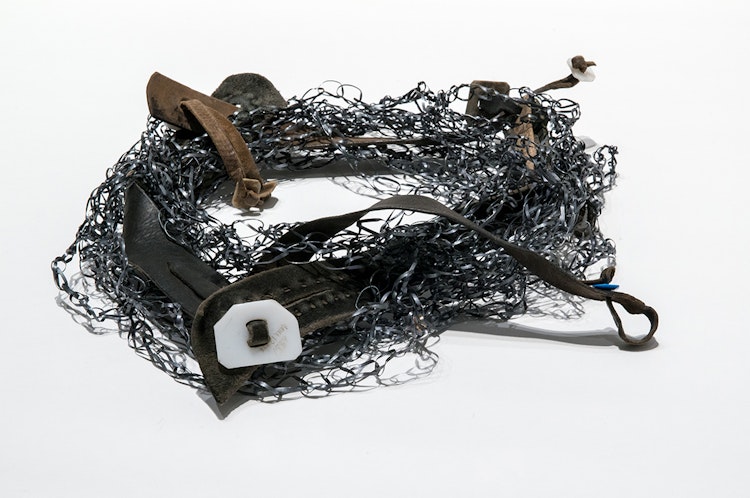
Social interaction and cooperation across borders
Social interaction means a lot to Kvammen. She and her husband took the initiative to set up a cooperative living arrangement with friends and other invitees back when they built their house at Hessing in 1985.
‘We ended up being eight families who built homes laid out in a circle, with communal areas and no fencing. Some of us share a green house, others share a sauna, and some have meals together once a week. We get together to bake and sew, we take trips together, have social gatherings and so on. This cooperative has been, and still is, valuable, stabilising, and a safe place to live.’
In the same way as she seeks out other indigenous groups in order to put her Sámi roots in perspectives, Kvammen visits other social communities to get a new angle on her own lifestyle and that of others in the area where she lives. An example of how this comes to expression is the series Eriste Archives (2015), which came into being after she travelled to Southern Caucasus and visited the border region between Georgia, Turkey and Armenia. While there, she took a closer look at women’s social interaction.
‘Traveling in the border region between Turkey and Armenia became a reflection on how we operate across the borders here in the North, and how, for example, different multicultural aspects and the preservation of old cultural traditions contribute to shaping solidarity and development.’
Kvammen believes different types of fellowship between people can create good societies and deter conflict. Getting to know other people by doing something together, for instance making food or dying wool, are everyday activities in themselves, but they can have great social significance. They are occasions for sharing opinions and knowledge and for coming to understand each other better.
‘The border between Armenia and Turkey is hermetically sealed. I travelled to Armenia via Georgia, meeting people who resembled each other in their cultural practices, food traditions and much else, but who had absolutely no contact. This is of course tragic’, says the artist, who thinks border regions are especially relevant to study now, what with the world suffering from a pandemic that has more or less closed national borders.
‘How will it be in the future? Our society here [in Norway] is of course completely dependent on having open borders with both Finland and Russia. We must cooperate across the borders in order to solve mutual challenges. We must learn to know each other in order to gain understanding and preserve the best aspects of a culture.’
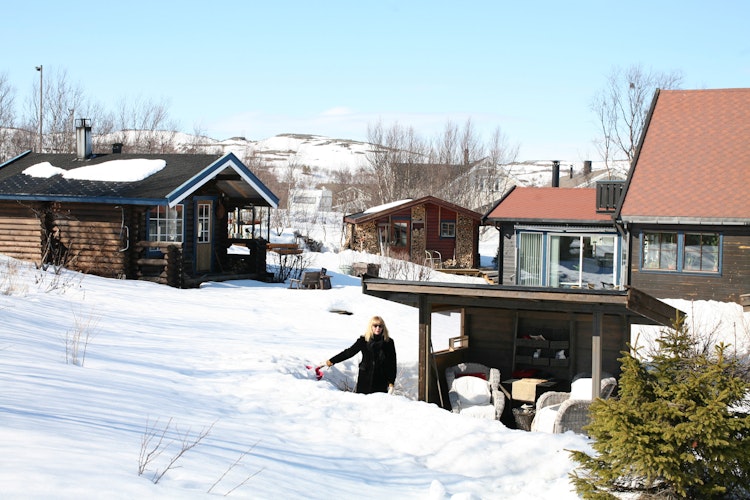
‘We must learn to know each other in order to gain understanding and preserve the best aspects of a culture.’
The role of the art institution
Sociocultural involvement and an interest in multicultural communication also come to expression in other parts of Kvammen’s practice. In addition to being and artist, she is a curator and jack-of-all-trades in the curatorial collective Pikene på Broen
(Girls on the Bridge), which she helped establish in 1996. Several of her trips and many of the people she has met are thanks to Pikene på Broen. She has also been a board member of several organisations, among others, the Sámi Artist Society, as well as of regional and national boards and committees. The artist has clear opinions about how the institutions should work in order to give Sámi artists the position they deserve. For her, it is important to acknowledge that what transpires in the North is globally significant and should be of global interest.
‘Everything that happens here actually has global consequences. Not only with regard to sustainable lifestyles and the climate, but also issues relating to the Barents Sea and cross-border cooperation. And so much of what happens here is strongly influenced by realpolitik. It’s like we’re right at the core of something.’
As Kvammen sees it, if one is searching for artists who can comment on themes relating to, for instance, the environment and today’s climate-related challenges, then many Sámi artists are relevant. It should therefore be an obvious choice to look to the Sámi art scene in such contexts.
‘Norwegian institutions that are tasked to mediate national narratives about Norway and Norwegian art and culture should of course include Sámi artists. That this has only happened to a minimal extent up until now is a real shame. Sami culture is a natural part of the narrative about Norway. And there’s as much of interesting happening in Sápmi as elsewhere in Norway.’
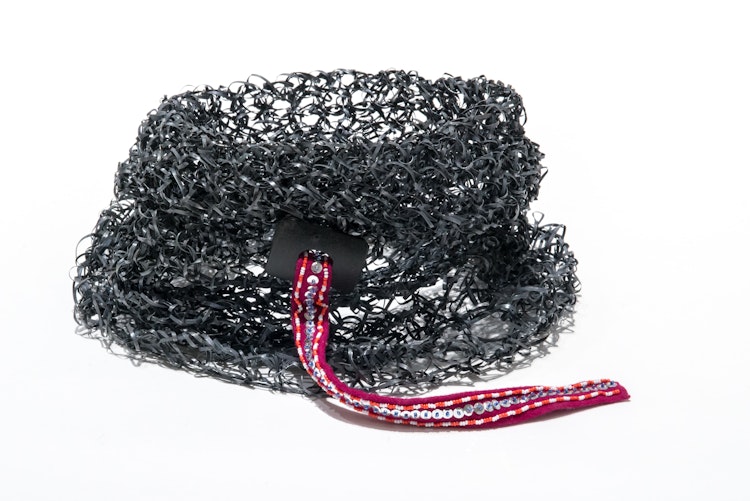
Even though the interest in Sámi art and culture now extends far beyond Sápmi and the Barents region, she still insists that Sámi art is still far too underrepresented.
‘I think it’s a shame that it has taken such a long time [for Sámi art to gain recognition], but it’s very good that there is now a focus on the Sámi stories and the way Sámi artists work and put their works across to a wider public. I’m also glad it’s starting to gain a position both nationally and internationally. [Sámi art] concerns the relationship to nature, the relationship to society, and the way of life. It concerns a great many themes that are relevant today, themes that need greater reflection if we are to provide for a sustainable future.’